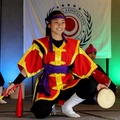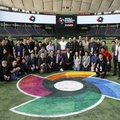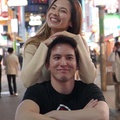Mitch Homma, a 3rd generation Japanese American, grew up and still lives in Southern California. He has long been interested in Japanese and Japanese American history. His family’s association with the American Baptist organization began four generations ago when his great-grandfather, Rev. Masahiko Wada, graduated from Yokohama Baptist Seminary and started a Baptist church in Japan around 1910. Homma has sought to organize, preserve, and share his family’s photo and document collection, which covers their missionary work in Japan, Manchuria, Korea, and Russia prior to coming to the U.S. as Baptist missionaries in 1928.
The Homma and Wada Family’s Immigration Story
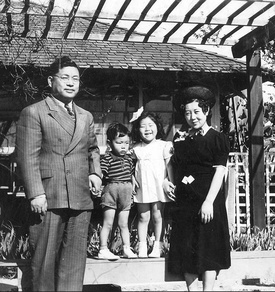
Mitch Homma’s grandfather, Kyushiro Homma, immigrated to the U.S. in 1917. Kyushiro was accompanied by his father, Hisaichi Homma. Kyushiro lived in Hollywood, California with his older brother Yorozu. Hisaichi Homma visited the U.S. a few times to learn about greenhouse farming and subsequently returned to Hamamatsu, Japan.
Kyushiro Homma had completed high school in Japan, but after he moved to the US, he attended Hollywood High School to learn English, graduating in 1924. He subsequently went to the University of Southern California School of Dentistry, completing his degree in 1929. He set up a successful dental practice in Sawtelle, CA, with several movie star patients, including Shirley Temple.
The Immigration Act of 1924, including the Asian Exclusion Act, prevented many Asians from immigrating to the U.S. In 1924 and later, the Homma and Wada families were able to enter the U.S. legally under the auspices of the American Baptist Home Missions Society. They came to the U.S. to help start Baptist Missions and Churches for Japanese American communities in Southern California.
In 1928, Rev. Masahiko Wada, the father of Mitch Homma’s grandmother, Mutsu Wada Homma, immigrated to California, sponsored by the American Baptist Home Missions Society. Mutsu followed her father to California in 1929. The rest of the Wada family arrived in 1931.
Kyushiro Homma met Mutsu Wada at his dental office in 1931. They became friends and married in 1933. They had three children, Kumiko, Hisao (Mitch Homma’s father), and Kunio.1
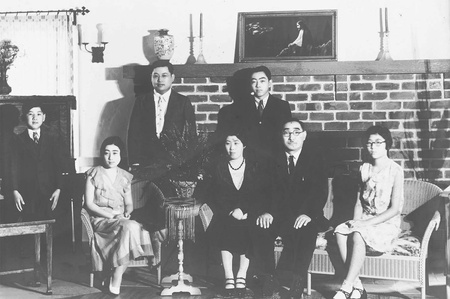
The Homma and Wada Families and the American Baptist Home Missions Society: Continued Support and Involvement
In addition to helping to bring Homma and Wada family members to the U.S. in the early part of the 20th century, the American Baptist organization continued to support the Homma and Wada families during and after World War II.
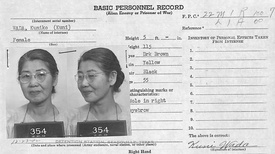
In 1942, Mitch Homma’s paternal great-grandparents, Rev. Masahiko Wada, an American Baptist minister based in Southern California, and his wife, Kuni Wada, a Japanese language teacher, were arrested by the FBI and taken to Department of Justice internment camps. “The American Baptist Home missionaries, former Baptist Japan missionaries, and Herbert Nicholson were the only ones to visit them while they were detained in Santa Fe and Lordsburg, New Mexico, and Seagoville, Texas,” recounted Homma. These missionaries kept other family members informed as to the status of Rev. and Mrs. Wada.
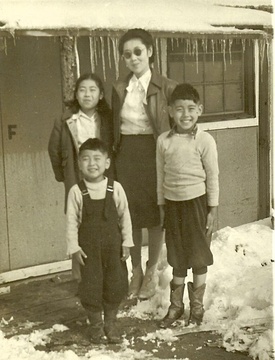
Homma’s paternal great-grandparents, Dr. Kyushiro and Mutsu Homma, were sent to Amache Internment Camp in Colorado in 1942. After Dr. Homma suffered a fatal heart attack and stroke in 1944, the American Baptist Home Missions Society was instrumental in getting Rev. and Mrs. Wada released so they could join the Homma family in Amache.
After the Wada and Homma families were released from Amache in September 1945, they relocated to Seattle WA. The Seattle Japanese Baptist Church community helped them to restart their lives. “The American Baptists found a pastorship for my great-grandfather, Rev. Wada, at Seattle Japanese Baptist Church. The family lived in the church parsonage for the next ten years,” said Homma.2
Mitch Homma has had a lifelong involvement with American Baptist Japanese American churches. Growing up in Torrance, CA, he attended Gardena Valley Baptist Church in Southern California. Whenever he visited family in Seattle, he attended Seattle Japanese Baptist Church, a practice that continues to this day. “Grandmother instilled in me the family relationship with the American Baptist organization and how much they helped the family during the WWII years,” said Homma.
He continues to be involved with various American Baptist organizations. “Recently, I helped Gardena Valley Baptist church with their 100th anniversary, giving them access to my family’s large collection of photos and documents. I am now helping the Seattle Japanese Baptist Church history committee and led their 120th Anniversary history video and history book teams. Also, I just finished my term as Vice President of the American Baptist Historical Society in Atlanta, GA and am still on their Board of Managers. I continue to support various American Baptist Home Missions and Alliance of Asian American Baptist Churches projects.”
Gathering and Organizing Historical Family Photographs and Documents

Mitch Homma’s great-grandparents, Rev. and Mrs. Wada, had organized many of the photographs and historical records in Seattle, but it took years to move them to Southern California. These records include the family’s work history, ordination papers, ledgers, timelines, church blueprints, and thousands of corresponding photographs.
Homma’s grandmother’s younger brother, Rev. Yasushi Wada, and other church members and scholars acquainted with the family helped him organize photos and records. He added that some very old Japanese documents and scrolls were returned to relatives in Japan to translate. These Japanese relatives provided additional photographs. From them, he learned that many Japanese records had been lost in the fire bombings during World War II.
After his grandmother, Mutsu Wada Homma, passed away in 2004, the family found her collection of photos, documents, and artifacts. “I knew that the family’s story needed to be shared with the rest of the family, so my first task was to create a Shutterfly family photo book. This photo book was a big hit among the family,” he recounted.
Homma’s next project was to help the American Baptist Historical Society document the early Christian and Baptist movements in Japan, especially since many of the records had been lost in the firebombing during World War II.
The Japanese American National Museum’s 2008 conference, “Whose America? Diversity, Civil Liberties, and Social Justice” helped Homma recognize the significance of these WWII era artifacts. “It made me realize how important this material was to the community beyond my own family,” he related. “Just before the conference, I started creating photo albums on Discover Nikkei. The Discover Nikkei team used some of these photos during the conference. So many families came up to me and shared their stories, and I realized that this was just the tip of the iceberg.”
Homma was inspired to help other church families recapture some of their family histories in Japan before World War II. At this conference, the Homma family was able to reconnect with Alice Setsuko Imamoto to help heal 66 years of separation.3
Contributing Historical Family Stories and Photos to Discover Nikkei
Over the years, Mitch Homma has contributed a wealth of family stories and photos to Discover Nikkei. “My Discover Nikkei experience has been extremely beneficial, and I hope that I am able to give back to the community, too,” said Homma. “Through Discover Nikkei, I have met some incredible researchers who have helped me to connect family stories to historical events.”
Researchers, movie and stage producers, missionaries, and other families have shown a particular interest these Discover Nikkei albums:
- Incarceration Years: Lordsburg/Santa Fe, Seagoville, Amache Camp Photos and DOJ Documents
These photos document some of the key WWII era artifacts from Santa Fe and Lordsburg, Seagoville Women’s Detention, and Amache. Grandfather Homma had brought his cameras to Amache as dental equipment and was able to take photographs at Amache. - Heart Mountain Photos from Michihiko “Mike” Wada, son of Rev. and Mrs. Wada
Michihiko "Mike" Wada, the son of Rev. and Mrs. Wada, had moved to New York in 1939 to study aeronautical engineering at New York University. When the FBI arrested Rev. and Mrs. Wada in 1942, he returned to California. Caught up in the government travel curfews imposed on Japanese Americans, he was sent to Pomona Assembly Center and then to Heart Mountain Internment Camp in Wyoming. An avid photographer, he had his cameras shipped from New York to Heart Mountain where he started taking photos inside the barbed wire. - Baptist Churches in Pre-WWII Imperial Japan
This album highlights the Wada family’s missionary work in Japan and other parts of Asia before 1930. These photos have attracted the attention of many researchers in the US and Japan. - Moneta /Gardena Valley Baptist Church (1930-1940)
The Wada family served at the Monet/Gardena Valley Baptist Church for over 10 years. It was considered one of the cornerstone Southern California Baptist churches before World War II, along with Evergreen and Los Angeles Baptist Churches. It was at Gardena where Kuni Wada helped develop the Sunday School, modeled after the famous Kure Baptist Sunday School in Hiroshima-ken, Japan. Mitch Homma later grew up attending this church.
Homma reflected on the significance of Discover Nikkei. “As the Nikkei community is worldwide now, Discover Nikkei provides a common thread of connectivity. Discover Nikkei is a multimedia community digital tool linking a wider audience outside of a particular region.”

The Amache Alliance and the Signing of the Amache National Historic Site Bill (H.R. 2497) in 2022
Homma’s work on Discover Nikkei and getting feedback and inspiration from Amache survivors led him to get involved in Amache preservation efforts. This in turn led to the formal creation of the 501.c3 nonprofit Amache Alliance organization which supported the campaign to make Amache part of the National Park System. As part of this campaign, the Amache Alliance referred many U.S. Congress members, staffers, and other advocacy groups to the Discover Nikkei website to learn the stories of Amache families.
In March 2022, President Biden signed the Amache National Historic Site Bill (H.R. 2497), which authorized the establishment of Amache as a unit of the National Park System to “preserve, protect, and interpret for the benefit of the present and future generations resources associated with the incarceration of civilians of Japanese ancestry during World War II....”4
Notes:
1. “Kyushiro ‘John’ Homma: Amache,” NVC Foundation Japanese Americam Memorial Wall.
2. For more information, see Discover Nikkei, “Incarceration Years: Lordsburg/Santa Fe Seagoville, Amache Camp Photos and DOJ Documents” and Densho Digital Repository for an interview with Mutsu Homma on August 27, 1997.
3. See the Discover Nikkei story, “Paul Howard Takemoto and Alice Takemoto: On Resettlement, Revisiting the Past, and Reconnection - Part 2 of 2.”
4. Summary: H.R.2497 - 117th Congress (2021-2022).
* * * * *
For Every Generation: Recovering and Sharing Family Histories
Saturday August 13 from 2-3:30pm at JANM (In person / Virtual)
Join us as we learn from Dr. Gail Y. Okawa, Mitch Homma, Elizabeth Nishiura, and Laura Dominguez-Yon about their families and the efforts they’ve made to record and share their stories and preserve the unique and rare objects that are featured in Sutra and Bible. Nancy Ukai, Project Director of 50 Objects, will moderate the conversation.
© 2022 Karen Kawaguchi


